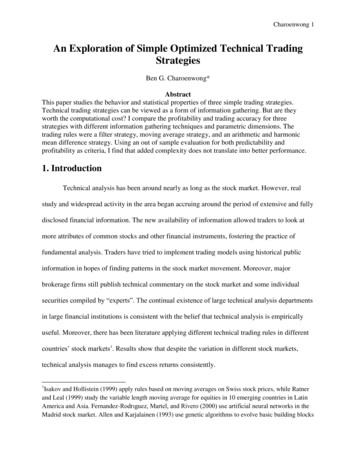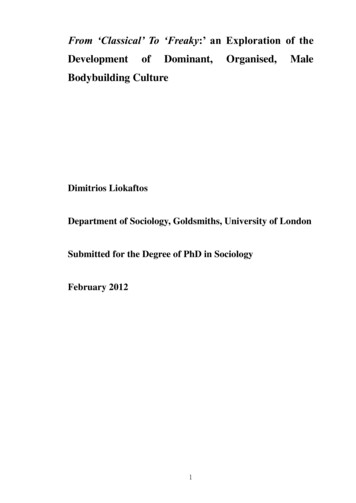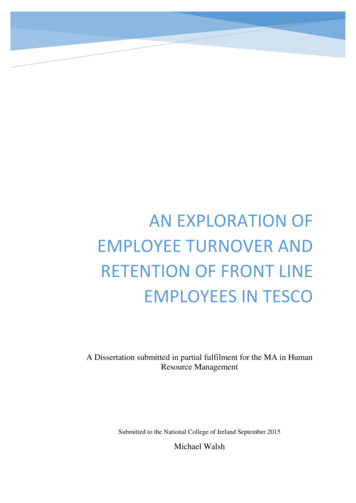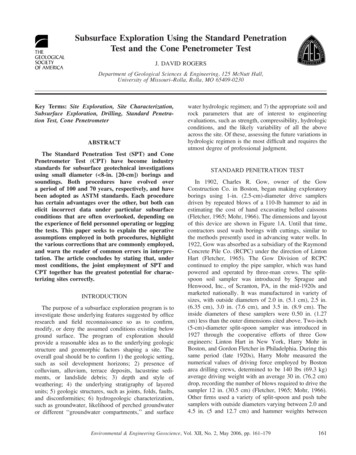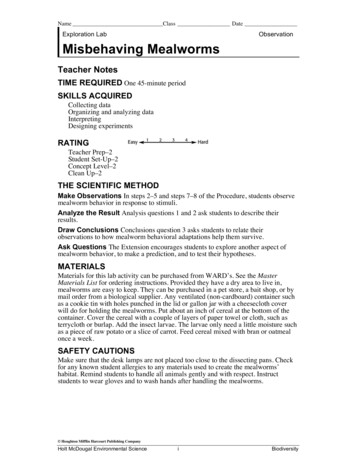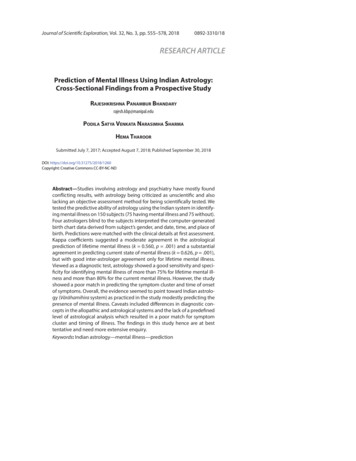
Transcription
AN EXPLORATION INTO THE EVOLUTION OF TUTORING,A COMPREHENSIVE BUSINESS PLAN FOR LAUNCHING THE ONLINETUTORING COMPANY SHORTWORK LLCANDA POST-OPERATIVE ANALYSIS OF SHORTWORK’S BUSINESS MODELBy William Laurence TribbleA thesis submitted to the faculty of The University of Mississippi in partial fulfillment ofthe requirements of the Sally McDonnell Barksdale Honors CollegeUniversity, MississippiMay 2019Approved:Advisor: Owens AlexanderReader: Dr. Robert BrownReader: Dr. Adam Smith
2019William Laurence TribbleALL RIGHTS RESERVED!ii
ACKNOWLEDGEMENTSI want to give equal credit for Shortwork to Sam Harres. You spent an entiresemester in the trenches with me taking our idea from a conversation over lunch to afully-fledged business. It took late nights and long hours to make it work, and it wouldnot have been possible with you.Thank you to Owens Alexander and the Center for Innovation andEntrepreneurship. Without your guidance, encouragement, and belief in me, neitherShortwork nor this thesis would have been possible.Thank you to my readers, Dr. Bob Brown and Dr. Adam Smith, for yourparticipation in the production of this thesis and your support during my time at thisUniversity.Thank you to my family for supporting me throughout my education and inspiringthe ideas behind this business. You all have given me more than I can ever repay.!iii
ABSTRACTThis thesis consists of a review of the history of tutoring and homework up to themodern day; the original business plan used to launch Shortwork LLC, an online tutoringcompany, in the Spring of 2018; and a post-operative analysis of its business model andexecutive decision-making, as well as discussion about the future of education. Thebusiness plan includes a competitive analysis of the online tutoring market, an overviewof Shortwork’s management structure, an explanation of its product model andtechnology, and both the financial and strategic details of its Spring 2018 plans for 3-yeargrowth. The concluding section of this thesis, written one year after founding, examinesShortwork’s successes and failures, resulting in critiques to the original business strategy,as well as the role technology could continue to play in education.Formal education, which developed in different cultures millennia ago, requiresonly two fundamental elements: an instructor and a student. As formal education hasexpanded, so too have the number of instructors and students, but not at the same rate. Asstudent populations have outpaced instructor populations, the individuality of instructionhas declined.The tutoring industry exists today because students struggle outside of theclassroom and not just inside it. For the most part, it has mimicked the classroom!iv
experience; tutors meeting in person with students to teach a subject. One of the primaryroles of tutors today is to assist with homework, the take-home portion of most students’education that evolved generations ago. The digital revolution, however, has allowedonline learning to challenge the traditional mold of study aids such as tutors.Shortwork was founded to provided students with an affordable, online solution tothe all-too-common problem of needing homework help. The service was built around itsfounders’ experience helping real high schoolers, and early versions of the service testedwell with current students. Its early success carried promise, and the company attractedover 10,000 in competition prizes within only three months of establishment as an LLC.Due to poor choice in target market and diverging entrepreneurial visions for thecompany, however, Shortwork failed to maintain its momentum over the summer after itsfounding. By the end of 2018, its founders had decided to suspend the service untilfurther notice. This thesis examines why they came to that decision.!v
TABLE OF CONTENTSLIST OF TABLES. . .viiiPART I: THE EVOLUTION OF TUTORING 1A. Introduction .1B. The History of Personal Tutoring and Homework . 1PART II: SHORTWORK, LLC BUSINESS PLAN . .6A. Executive Summary . .6B. Market Analysis . . .81. Problem Identification . 82. Target Market . .9C. Organization Structure .101. Management . .102. Ownership .103. Advisement . 11D. Shortwork’s Solution .11E. Operations . 121. Sales Plan . . 122. Technology . . . 13F. Go To Market Strategy . . 14G. Competitive Analysis . . .161. Current Alternatives . .162. Shortwork’s Advantages . .17H. Finances . . .191. Financial Overview 192. Use of Funds . 20I. Success Indicators .211. Milestones . .212. Key Metrics. . . 21!vi
J. Summary . .23K. Financial Statements .25PART III: POST-OPERATIVE ANALYSIS . . .31A. Analyzing Shortwork’s Successes and Shortcomings . . .31B. The Likely Future of Tutoring . .33LIST OF REFERENCES . .35!vii
LIST OF TABLES1. Table 1: Income Statement, FY2019, Monthly Detail 322. Table 2: Income Statement, FY2019–FY2021, Annual Detail . 333. Table 3: Balance Sheet, FY2019, Monthly Detail . . .344. Table 4: Balance Sheet, FY2019–FY2021, Annual Detail . 355. Table 5: Statement of Cash Flows, FY2019, Monthly Detail . .366. Table 6: Statement of Cash Flows, FY2019–FY2021, Annual Detail. . .37!viii
PART I: THE EVOLUTION OF TUTORINGA. IntroductionThe history of tutoring, typically defined as the process by which someoneteaches someone else, usually on an individual-to-individual basis, traces its roots to thehistory of formal education (“Tutoring”). Formal education grew out of necessity as earlyas 3500 BCE, brought about by “the division of labor caused by the multiplication of theinterests of mankind which made it impossible for the home to continue wholly to carefor the training of its children” (Seeley, 19). “Educational history concluded long ago thatthe common school rose in spite of tutorial education,” according to Dr. Edward Gordonin his 1988 Ph.D. dissertation on the history of tutoring, in which he concluded thattutoring became viewed as “the outmoded prerogative of a few affluentchildren” (Gordon, 1). The trend away from individual tutoring has continued in somefashion ever since the creation of classroom education, but never so radically haseducation been democratized as by the digital revolution, the effects of which are stillbeing discovered.B. The History of Personal Tutoring and HomeworkThe history of personal tutoring is complicated by the fact that the term’s“meaning as an educational concept has shifted over time, country and culture” (Gordon,!1
2). One thing that stayed constant, however, was that “[tutors] identified themselvesclosely with their pupils” (6-7). Tutoring began with “the transmission of knowledgethrough oral tradition” millennia ago, and for generations they sufficed in educating theyoung (11). “In the early aristocratic days of Greece,” the glorified height of tutoring,“technical and literacy instruction were combined and taught” (18).With the advent of community schools closer to 200 BC, education began tochange, but tutors persisted, especially for aristocrats (13). During the Middle Ages, whentutoring took on a predominantly religious focus, “private tutoring as a home activity”declined before reviving much later (47). During the later Middle Ages, specifically theTudor Dynasty in England (1485 AD–1603 AD), royal tutors frequently foundthemselves in positions of power (153).During the 1800s, “Upper and middle class English families had ampleopportunities to educate their children at home in both modern and classicalsubjects” (228). As a result, “private tutors enabled many children to receive a morescientific and modern education than offered at most public schools or the universities,”forever tying private tutors to success thereafter (229). Furthermore, “because of thecontinued inadequacy of many schools even the lower middle class were using [tutors] by1865” (309).In the twentieth century, as American public schools improved, “[visiting]teachers had come into existence to supplement the work of the classroom teacher,especially in cases of retarded or failing pupils” (431). This is the beginning of themodern tutoring industry: “these teachers offered one-to-one instruction for remedial!2
education and special education” (432). The stigma around getting assistance outside ofthe classroom has persisted ever since.Homework developed in parallel with the tutoring model and likely contributed toits rise. Early schooling theory revolved around repetition and discipline (Vatterott). Earlyschooling was verbal instead of written. Because students need varying amounts of timeto learn the same information, students would frequently have to practice their lessonsverbally at home. As in-school work pivoted to written instruction, homework toobecame mostly written (Vatterott).Homework has weathered volatile support (and lack thereof) in America. In thenineteenth century, it was popular. Early in the next century, progressives successfullyfought to minimize homework in schools, even abolishing it in many school districts. TheSpace Race against Soviet Russia galvanized Americans to reconsider homework as botha vehicle for and test of intellectual prowess. The cultural pendulum swung back towardanti-homework sentiments during the Vietnam War-era countercultural movements.By the 1980s, Americans had decided again that homework was “an effectivelearning strategy” (Vatterott), and the Department of Education began prioritizing higherstandards in schools. The result became a “[focus] on strategies for getting children tocomplete homework” (Vatterott). The University of Michigan has since found that“homework for 6- to 8-year-olds had increased by more than 50 percent from 1981 to1997” (Vatterott). As “homework increased, and parents began feeling overwhelmed the mood [became] one of concern for overworked students and parents” (Vatterott).!3
Gordon closes his dissertation with the assertion that “ the challenge of betterschooling requires a much broader study of tutorial philosophy and methods” (Gordon,464). He argues, correctly, that “the tutor and teacher are not in competition with oneanother. Instead they seek an answer to the question of how a new alliance of ‘tutoring’and ‘teaching’ will best serve society's learning requirements” (464).One result of the increase in homework load and related parent stress has been anincrease in private tutoring. Private tutoring allows for concerned or overworked parentsto support their children’s studies outside of the classroom and even at home. Parallelingthe revival of homework in 1980 and 1990s, “the last 20 years are when [private tutoring]became a really widespread phenomenon,” both in America and globally (Jon).As a result of the digital revolution, the relationship between homework, tutoring,and teaching has been forced to change even since Gordon published his dissertation in1988. Electronics, and their ever-increasing affordability, have changed the way peoplerecord and share information. Online classrooms and self-guided courses have allowedfor more flexibility both in and out of school-based education (“The TechnologicalRevolution in Education and What It Means for Your Career.”).Just as students no longer have to sit in classrooms to learn from in-personteachers, tutors no longer have to visit a student in person to assist them outside of class.While the various culturally-dependent definitions of “tutor” might have all shared a levelof personal connection inherent to the person-to-person contact of traditional schoolingmethods, that element may soon be left behind as education turns to the internet for newways to educate students. This has led entrepreneurs around the world to start companies!4
and industry giants to prioritize digital learning, together beginning to define the digitalfuture for education (Kejriwal). Despite the rise of online educational services in the lastdecade, video-format online tutoring for homework remained unavailable to students. Iidentified the opportunity to address that open segment of the market, and in 2018 Ilaunched my own startup to test the possibility that personalized video instruction overthe internet could be the most promising direction for tutoring to develop.!5
PART II: SHORTWORK, LLC BUSINESS PLANA: Executive SummaryOur younger brothers, Jack and Charlie, get stuck on homework problems everyonce in a while, and they usually text us for help. Jack and Charlie feel like they onlyhave two choices: give up on the problem and hope there’s not one like it on the test, orpay 40 for an hour with a tutor just to cover a single homework problem. We believethere’s a gap between those extremes, one that existing options aren’t addressing verywell. Ideally, students would have 24/7 access to customized homework help at the clickof a button.Shortwork is an online marketplace where customers can list homework questionsand receive videos from college students explaining how to solve them. Customers arecharged 3 per problem, 2 of which goes to the solver. Payment is securely handledthrough Stripe integration, and customers aren’t charged until their problem is solved.The only personal information Shortwork collects are customers’ first names and phonenumbers. Customers upload a photo of their problem directly to Shortwork’s website.Veri
modern day; the original business plan used to launch Shortwork LLC, an online tutoring company, in the Spring of 2018; and a post-operative analysis of its business model and executive decision-making, as well as discussion about the future of education. The business plan includes a competitive analysis of the online tutoring market, an overview
